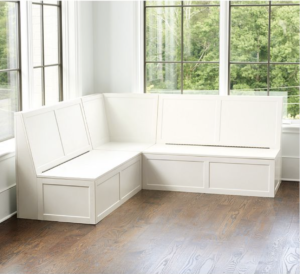When space is at a minimum in your kitchen or dining room, banquette seating is a great way to solve a problem with form and function. Using the contour of the room, you can create seating that continues other design themes of the room, letting the banquette serve a decorative purpose when it’s not in use.
Follow the Room’s Contours
If you have an area such as a corner, bay window or other indention or unique shape, consider lining it with your banquette. A simple L in a corner is a practical way to use otherwise dead space.
Putting a banquette in a recessed window lets you use the glass and millwork of the bay as design elements by marrying the seating to the window’s design. Add an elegant window treatment and pillows to elevate the space beyond simple functionality.
Take Advantage of Counters
If you plan on putting your kitchen table on the other side of a kitchen counter, place the banquette along the side of the counter opposite the kitchen. This works especially well if you are using a kitchen counter as a half wall to define your space. Use a floating bench, rather than a box, to create a less bulky look.
Add Storage Underneath
To eliminate the need for another piece of furniture or to add needed storage space, make the banquette a box with front doors or a top that opens. For convenience, keep place mats, napkins, candles and other dining objets in the banquette to make entertaining preparations easier. Let the seat hang over the box a bit so guests legs won’t rest against door handles or knobs.
Angle the Corners
To make it easier for guests to get in and out recessed seating with a fixed table in between two seats, angle the leading edges of the banquette to give legs an easy head start for the slide inward.
Additional Resources
